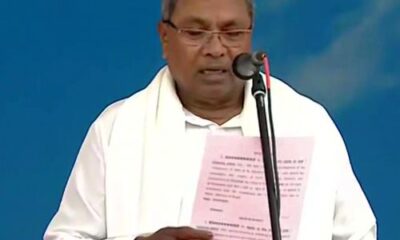Sci/tech
SIAC tribunal dismisses Ashneer Grover’s challenge, BharatPe case to continue
New Delhi, March 12 (IANS) The Singapore International Arbitration Centre (SIAC) has dismissed Ashneer Grover’s challenge to its jurisdiction on its power to decide on the claw back of his shares in the fintech unicorn BharatPe he co-founded.
People aware of the development told IANS on Tuesday that SIAC has also dismissed Grover’s stay application and the proceedings in the BharatPe case will continue before the arbitration tribunal.
BharatPe in late 2022 had filed an arbitration under the SIAC rules to restrict Grover from vesting his 1.4 per cent shares in the company.
Grover then held about 8.43 per cent stake in the company, of which 1.4 per cent is unvested.
According to the people close to the development, Grover had asked for a stay of proceedings in the Singapore tribunal, in light of his case filed in National Company Law Tribunal (NCLT) Delhi.
Grover, former co-founder and managing director of BharatPe, moved the NCLT in the Capital against the fintech major, alleging “oppression and mismanagement at the firm”.
The SIAC has now passed a detailed order, rejecting his applications and holding that the tribunal has the jurisdiction to hear the company’s case and NCLT case has no bearing on this present case, according to sources.
Grover will lose his unvested shares and right to use the founder title if the arbitration is granted.
In November last year, the Delhi High Court imposed a fine of Rs 2 lakh on Grover in response to alleged defamatory social media posts against the fintech company.
After Delhi Police’s Economic Offences Wing (EOW) filed an FIR against Grover and members of his family, BharatPe had filed an application alleging that Grover had been tweeting defamatory statements ever since.
In its suit, running into 2,800 pages, BharatPe has claimed damages worth Rs 88.67 crore from Grover, his wife Madhuri Jain Grover and his brother for alleged cheating and misappropriation of funds.
–IANS
na/prw
Sci/tech
21.67 lakh new workers enrolled in ESIC scheme in June, 10.58 lakh young employees

New Delhi, Aug 22 (IANS) The Centre on Thursday informed that 21.67 lakh new employees were enrolled under the ESIC scheme in June, ensuring social security to more workers.
The year-on-year (YoY) analysis showed a growth of 7 per cent in net registrations compared to June 2023.
As per provisional payroll data of ESIC (Employees’ State Insurance Corporation), 10.58 lakh young employees up to the age group of 25 years constitute new registrations.
According to the data, 13,483 new establishments were registered under the ESIC scheme in June.
“Through the data, it is noticeable that out of the total 21.67 lakh employees added during the month, 10.58 lakh employees amounting to around 49 per cent of the total registrations belong to the age group of up to 25 years,” according to the government.
The gender-wise analysis of the payroll data indicates that net enrolment of female members has been 4.32 lakh in June.
Besides, a total of 55 transgender employees have also got registered under the ESI scheme in June “which attests the commitment of ESIC to deliver its benefits to every section of the society”.
In May, 23.05 lakh new employees were added in the ESIC scheme, which represented a growth of 14 per cent in net registrations compared to the same month last year.
The data showed that out of the total 23.05 lakh employees added during the month, 11.15 lakh employees amounting to around 48.37 per cent of the total registrations belong to the age group of up to 25 years.
The net enrolment of female members was 4.47 lakh in May. In April, 16.47 lakh new employees were added out of which close to half are youngsters aged up to 25 years.
A total of 60 transgender employees were registered under the ESIC scheme during the month of May.
–IANS
na/
Sci/tech
Sunita Williams’ fate hangs in balance as NASA weighs return options

Washington, Aug 22 (IANS) NASA astronauts Sunita Williams and Butch Wilmore arrived at the International Space Station (ISS) on June 6 and more than two and a half months later, their fate hang in balance as NASA mulls several options which can delay their return to earth to even February next year.
The astronauts left for the orbiting laboratory on June 6 aboard the Boeing Starliner after lifting off on June 5 from Space Launch Complex-41 at Cape Canaveral Space Force Station in Florida in the US.
Originally slated to return within a week, their stay could now potentially stretch to over eight months owing to serious issues with Starliner.
According to the US space agency, if it decides to return Starliner uncrewed, Sunita and Butch would remain aboard station until late February 2025.
NASA would replan the agency’s SpaceX Crew-9 mission by launching only two crew members instead of four in late September. The two stuck astronauts would then return to Earth after the regularly scheduled Crew-9 increment early next year.
According to reports, it Elon Musk-run SpaceX is tasked with the return of Sunita and Butch, it will a major embarrassment for its rival Boeing.
At a press event, NASA officials said they have reached a point where, in the last week in August, “we really should be making a call, if not sooner”.
Bowersox said the astronauts were “making the best” of their extra time aboard the ISS “but I’m sure they’re eager for a decision, just like the rest of us.”
The US space agency is under tremendous pressure to make a quick yet safe decision regarding the astronauts’ return.
According to the US space agency, no final decisions have been made.
“NASA continues to evaluate all options as it learns more about Starliner’s propulsion system. Butch and Suni may return home aboard Starliner, or they could come back as part of the agency’s SpaceX Crew-9 mission early next year,” it said.
The International Space Station is “well-stocked with everything the crew needs, including food, water, clothing, and oxygen”.
Recently, a Northrop Grumman Cygnus spacecraft carrying 8,200 pounds of food, fuel, supplies, and science and a Progress resupply spacecraft carrying three tonnes of cargo arrived at the station.
NASA has additional SpaceX resupply missions planned through the end of 2024.
–IANS
na/
Sci/tech
JNCASR, HZL pact paves way for advance energy storage solutions in India

New Delhi, Aug 22 (IANS) A recent Memorandum of Understanding (MoU) between Jawaharlal Nehru Centre for Advanced Scientific Research (JNCASR), an independent institution under the Department of Science and Technology (DST), and Hindustan Zinc Limited (HZL) marks a significant advancement in the development of energy storage solutions in India.
The partnership intends to expedite the commercialisation of zinc-ion batteries and create novel zinc material types.
Because of its greater performance and lower cost, zinc-ion batteries are becoming more and more popular as a viable replacement for the more expensive and foreign lithium-ion batteries.
Because of the abundance of zinc in the Earth’s crust and the material’s inherent safety, these batteries have the potential to have a big impact on the market due to their large-scale energy storage capabilities.
The promise for zinc-ion batteries to completely transform the energy storage industry has been reinforced by recent developments in material stability and performance over a wide temperature range.
The commercialisation of zinc-ion batteries is contingent upon the resolution of various obstacles, including the thermodynamic instability of zinc in solutions including water, notwithstanding their promising nature.
By creating novel zinc alloys for use as anodes and altered electrolytes to increase the longevity and safety of the batteries, JNCASR and HZL want to overcome these issues.
The JNCASR research group of Professor Premkumar Senguttuvan has established a solid framework for zinc-based battery research, producing noteworthy publications and piquing the interest of industrial players.
Through this agreement, scalable zinc-ion pouch batteries appropriate for large-scale commercial applications will be developed by utilising JNCASR’s research knowledge and HZL’s product creation skills.
This project represents a turning point in the development of battery technology as India transitions to a sustainable energy future.
It is in line with two important Sustainable Development Goals, SDGs 7 (Affordable and Clean Energy) and SDG 13 (Climate Action).
–IANS
ts/rad
Sci/tech
Beyond the smartphone: POCO Pad to usher in 5G phablet era

Mumbai, Aug 22 (IANS) Global smartphone brand POCO on Thursday said that drawing inspiration from the phablets that first blurred the lines between phone and tablet, its new Pad has gone a step further.
By harnessing the power of 5G and integrating it into a user experience designed for a generation that lives life on the go, POCO offers a glimpse into a future where seamless connectivity is the norm. This isn’t just about bigger screens; it’s about expanding the boundaries of how and where we interact with the digital world.
POCO Pad reimagines the phablet for today’s users. While phablets strived to remain pocketable, the POCO Pad embraces its tablet form factor, offering a truly expansive 12.1-inch canvas for work and play. It’s the perfect size for those who found phablets a tad too cramped but still crave a portable powerhouse.
Phablets were limited by the connectivity of their time. The POCO Pad harnesses the power of 5G, enabling lightning-fast downloads, seamless streaming, and lag-free video calls – activities that were often a pipe dream on earlier large-screen devices.
Phablets hinted at the potential for mobile productivity, but the POCO Pad delivers. Its powerful processor, long-lasting battery, and optional accessories like a keyboard make it a true productivity companion, whether you’re editing documents, creating presentations, or managing your busy schedule.
The POCO Pad transforms into a portable entertainment hub with a stunning 2.5K display, Dolby Atmos sound, and all-day battery life. Binge-watch your favorite shows, immerse yourself in games, or video chat with friends and family – all with a level of quality and immersion that phablets could only dream of.
The company said that POCO Pad offers a large screen, portability, and versatility – and elevates them to new heights with cutting-edge technology and a focus on delivering an exceptional user experience.
–IANS
avs/na
Sci/tech
Concerning spike in back and spine problems due to excessive gadget use: Doctors

New Delhi, Aug 22 (IANS) The excessive use of gadgets among individuals aged 20 to 55 is leading to a significant increase in back and spine problems, doctors warn.
Many are experiencing severe and debilitating symptoms, including sharp, stabbing, or dull pain in the back or neck, muscle spasms, tingling, loss of sensation, and even weakness or limited mobility.
Prolonged screen time is increasing musculoskeletal disorders, particularly affecting the spine, with severe pain, tingling, and functional weakness being reported.
“In this digital era, prolonged screen time is causing a rise in musculoskeletal disorders (MSD), particularly affecting the spine. There has been a 60 per cent surge in back and spine issues. Individuals aged 20-55 are reporting severe pain, sometimes accompanied by loss of urinary or bowel control, tingling in the extremities, and functional weakness. Seven in ten patients I see daily suffer from back and neck pain,” Mohit Muttha, Orthopaedic & Spine Surgeon at Apollo Spectra, Pune told IANS.
“Poor posture, especially forward head posture (FHP), due to excessive gadget use, leads to muscle imbalances and tightened hip flexors, making daily activities stressful and painful,” added Muttha.
“A 60 per cent increase in low back and neck issues among 20-45-year-olds is linked to gadget addiction, causing discomfort in the neck and cervical spine. If neglected, this can lead to more severe issues, including neck pain, shoulder stiffness, headaches, and restricted mobility. Out of 10-12 patients who visit me daily, around 4-5 have neck and lower back pain related to gadget misuse,” Ram Chaddha, Spine Surgeon at Lilavati Hospital, Mumbai told IANS.
Regular breaks, posture, and daily exercises like yoga and stretching are crucial for preventing back and spine issues among 20-50-year-olds.
“There is a concerning 50 per cent surge in back and spine issues among people aged 20-50. Out of five patients, at least 2-3 suffer from back pain and are advised to rest for prompt recovery,” Burhan Salim Siamwala, Consultant Spine Surgeon at Medicover Hospitals, Navi Mumbai told IANS.
–IANS
ts/svn
-
Video2 years ago
PM Modi Attacks Congress in Karnataka with “Kerala Story”
-
Politics2 years ago
Siddaramaiah & DK Shivakumar sworn in as Chief Minister & Deputy CM respectively
-
Cricket2 years ago
CSK players rejoice 5th IPL title with their families (Pics)
-
Entertainment2 years ago
Karan Deol weds his longtime Girlfriend Drisha Acharya (Pics)
-
Sports7 years ago
History Of Official FIFA WORLD CUP Match balls
-
India2 years ago
Ashwini Vaishnaw: Railway Board recommends CBI probe in the Odisha railway disaster
-
Entertainment2 years ago
Urvashi Rautela dazzles on Cannes 2023 red carpet (Pics)
-
Entertainment2 years ago
Sunny Leone gets ready for Kennedy premiere in Cannes (Pics)
































